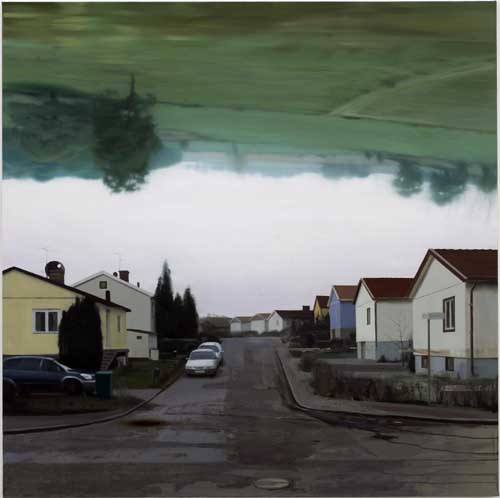Here’s an image I ran across in the LA Times this morning that I wanted to share:
It’s a painting entitled “The Bridge” by Swedish painter Tommy Hilding in his current Urban View show at the Angles Gallery in Santa Monica. I haven’t seen it live in person, but the reviewer talks about how the image is constructed from “screen-printed dots, puddles of photo emulsion” with “smeared squeegee marks over the images.” In that way, the work references photographs, and more specifically photographs in reproduction.
In the way the rural landscape hangs over the banal homes, streets and gardens, however, it also strongly references the camera obscura and photography using camera obscura-like inverted images. The photographer most known for doing this currently is Abelardo Morell. He basically takes a room somewhere, draws all the shades, pokes an aperture into the shade, and lets the inverted image of what’s outside shine inside, turning the room into a camera obscura. He then photographs the dim image cast on the wall with a view camera using a long exposure, sometimes several hours. Here’s one of his camera obscura images that he made, this one here in San Diego County at the Hotel del Coronado:

Abelardo Morell: Camera Obscura Image of Hotel Coronado in Room, San Diego, CA, 1998
For me, Morrell’s camera obscura images are visually striking but ultimately unresolved. Yes, they play with the ideas of indoor/outdoor, public/private, but ultimately I don’t find the images to be particularly nourishing. (There are other examples of his work, though, that I really do like quite a bit.) Other photographers are now copying Morell’s technique, but what I’ve seen hasn’t gone into any territory not already explored by Morell.
Another photographer who’s mined somewhat related territory where a right-side-up image is fused with an upside-down one is Harry Callahan in some of his multiple-image experiments. These are shots where the featureless sky prints out white from the relatively intense amount of exposure the sky areas get in relation to the rest of the image. Since the sky prints white, and since he’s inverting the camera between exposures, the tops and bottoms of these images are white. The only thing that isn’t white is a band of information in the middle of the picture that consists of a small piece of a building with another superimposed on top of it, upside-down. I don’t think Callahan had anything in mind other than doing some formal studies, and these images succeed brilliantly in doing just that. He sets a goal, then creates some stunning images that exemplify his intentions. Morell’s images are graphically interesting, but it’s the intention part that I’m not sure I get. So his camera obscura series doesn’t gel for me in the same way Callahan’s works do.
Anyway, Back to Tommy Hilding. In using this camera obscura-like trick of right-side-up and upside-down, he’s made an interesting image graphically. But there’s a richness to his image beyond the formal qualities. Is the green inverted landscape the more pristine land that was bulldozed and chopped up to create the blight below? It’s probably not as literal as that, but the question hangs in the air as much as the landscape hangs over the little suburban homes and barren patches of garden space. In Beauty in Photography : Essays in Defense of Traditional Values, the photographer Robert Adams quotes Albert Camus, who wrote that the the builders of the City of Oran had managed to “exorcise the landscape.” Is this what’s happened here? Is the original landscape hanging over all of our heads in our squalid little cities like some indictment? Is it the ghost of something that’s lost to us forever? Or is it hanging over us like some dark premonition, ready to drop and crush us?
